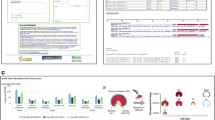Abstract
Angiosperm evolution is marked by numerous, recurring polyploidization events. While hybridization and polyploidization have greatly increased the degree of genetic and phenotypic diversity in plants, the mechanisms underlying changes in the genotype-to-phenotype relationships remain unclear. As the field of natural sciences continues to expand during the post-genomic era, large datasets are becoming increasingly common. However, the development of tools and workflows available to robustly assess these changes have lagged behind data production. A robust homoeolog-specific expression analysis strongly depends upon proper homoeolog calling, the ability to account for reference sequence biases, flexible and accurate methods for dealing with residual bias, and a reproducible workflow. To that end, this chapter aims to provide a detailed description of the potential pitfalls encountered while estimating homoeolog-specific expression as well as provide a workflow that allows for robust inferences based on precise estimates of expression changes.
Access this chapter
Tax calculation will be finalised at checkout
Purchases are for personal use only
Similar content being viewed by others
References
Turro E, Su S-Y, Gonçalves  et al (2011) Haplotype and isoform specific expression estimation using multi-mapping RNA-seq reads. Genome Biol 12:R13
Wittkopp PJ, Haerum BK, Clark AG (2004) Evolutionary changes in cis and trans gene regulation. Nature 430:85–88
Wolf JBW (2013) Principles of transcriptome analysis and gene expression quantification: an RNA-seq tutorial. Mol Ecol Resour 13:559–572
Love MI, Huber W, Anders S (2014) Moderated estimation of fold change and dispersion for RNA-seq data with DESeq2. Genome Biol 15:550
Pertea M, Kim D, Pertea GM et al (2016) Transcript-level expression analysis of RNA-seq experiments with HISAT, StringTie and Ballgown. Nat Protoc 11:1650–1667
Hu G, Wendel JF (2019) Cis-trans controls and regulatory novelty accompanying allopolyploidization. New Phytol 221:1691–1700
Miller BR, Morse AM, Borgert JE et al (2021) Testcrosses are an efficient strategy for identifying cis-regulatory variation: Bayesian analysis of allele-specific expression (BayesASE) G3 11. https://doi.org/10.1093/g3journal/jkab096
Nieto Feliner G, Álvarez I, Fuertes-Aguilar J et al (2017) Is homoploid hybrid speciation that rare? An empiricist’s view. Heredity 118:513–516
Boatwright JL, McIntyre LM, Morse AM et al (2018) A robust methodology for assessing differential homeolog contributions to the transcriptomes of allopolyploids. Genetics 210:883–894
McKenna A, Hanna M, Banks E et al (2010) The genome analysis toolkit: a mapreduce framework for analyzing next-generation DNA sequencing data. Genome Res 20:1297–1303
Haas BJ, Papanicolaou A, Yassour M et al (2013) De novo transcript sequence reconstruction from RNA-seq using the Trinity platform for reference generation and analysis. Nat Protoc 8:1494–1512
Manado Manado Press (2016) Corset: enabling differential gene expression analysis for de Novo assembled transcriptomes. CreateSpace Independent Publishing Platform
Soltis DE, Gitzendanner MA, Stull G et al (2013) The potential of genomics in plant systematics. Taxon 62:886–898
Glover NM, Redestig H, Dessimoz C (2016) Homoeologs: What are they and how do we infer them? Trends Plant Sci 21:609–621
Krasileva KV, Buffalo V, Bailey P et al (2013) Separating homeologs by phasing in the tetraploid wheat transcriptome. Genome Biol 14:R66
Moreno-Hagelsieb G, Latimer K (2008) Choosing BLAST options for better detection of orthologs as reciprocal best hits. Bioinformatics 24:319–324
Hernández-Salmerón JE, Moreno-Hagelsieb G (2020) Progress in quickly finding orthologs as reciprocal best hits: comparing blast, last, diamond and MMseqs2. BMC Genomics 21:741
Remm M, Storm CE, Sonnhammer EL (2001) Automatic clustering of orthologs and in-paralogs from pairwise species comparisons. J Mol Biol 314:1041–1052
Emms DM, Kelly S (2019) OrthoFinder: phylogenetic orthology inference for comparative genomics. Genome Biol 20:238
Li L, Stoeckert CJ Jr, Roos DS (2003) OrthoMCL: identification of ortholog groups for eukaryotic genomes. Genome Res 13:2178–2189
Kiełbasa SM, Wan R, Sato K et al (2011) Adaptive seeds tame genomic sequence comparison. Genome Res 21:487–493
Merkel D et al (2014) Docker: lightweight linux containers for consistent development and deployment. Linux J 2014:2
Kurtzer GM, Sochat V, Bauer MW (2017) Singularity: Scientific containers for mobility of compute. PLoS One 12:e0177459
Kuo TCY, Hatakeyama M, Tameshige T et al (2020) Homeolog expression quantification methods for allopolyploids. Brief Bioinform 21:395–407
Degner JF, Marioni JC, Pai AA et al (2009) Effect of read-mapping biases on detecting allele-specific expression from RNA-sequencing data. Bioinformatics 25:3207–3212
Stevenson KR, Coolon JD, Wittkopp PJ (2013) Sources of bias in measures of allele-specific expression derived from RNA-seq data aligned to a single reference genome. BMC Genomics 14:536
Skelly DA, Johansson M, Madeoy J et al (2011) A powerful and flexible statistical framework for testing hypotheses of allele-specific gene expression from RNA-seq data. Genome Res 21:1728–1737
Graze RM, Novelo LL, Amin V et al (2012) Allelic imbalance in Drosophila hybrid heads: exons, isoforms, and evolution. Mol Biol Evol 29:1521–1532
León-Novelo LG, McIntyre LM, Fear JM, Graze RM (2014) A flexible Bayesian method for detecting allelic imbalance in RNA-seq data. BMC Genomics 15:920
Fear JM, León-Novelo LG, Morse AM et al (2016) Buffering of genetic regulatory networks in Drosophila melanogaster. Genetics 203:1177–1190
Chen S, Zhou Y, Chen Y, Gu J (2018) fastp: an ultra-fast all-in-one FASTQ preprocessor. Bioinformatics 34:i884–i890
Ewels P, Magnusson M, Lundin S, Käller M (2016) MultiQC: summarize analysis results for multiple tools and samples in a single report. Bioinformatics 32:3047–3048
Kruschke JK (2010) Bayesian data analysis. WIREs. Cogn Sci 1:658–676
Shan S, Boatwright JL, Liu X et al (2020) Transcriptome dynamics of the inflorescence in reciprocally formed allopolyploid Tragopogon miscellus (Asteraceae). Front Genet 11:888
Di Tommaso P, Chatzou M, Floden EW et al (2017) Nextflow enables reproducible computational workflows. Nat Biotechnol 35:316–319
Author information
Authors and Affiliations
Corresponding author
Editor information
Editors and Affiliations
Rights and permissions
Copyright information
© 2023 The Author(s), under exclusive license to Springer Science+Business Media, LLC, part of Springer Nature
About this protocol
Cite this protocol
Boatwright, J.L. (2023). A Robust Methodology for Assessing Homoeolog-Specific Expression. In: Van de Peer, Y. (eds) Polyploidy. Methods in Molecular Biology, vol 2545. Humana, New York, NY. https://doi.org/10.1007/978-1-0716-2561-3_13
Download citation
DOI: https://doi.org/10.1007/978-1-0716-2561-3_13
Published:
Publisher Name: Humana, New York, NY
Print ISBN: 978-1-0716-2560-6
Online ISBN: 978-1-0716-2561-3
eBook Packages: Springer Protocols




